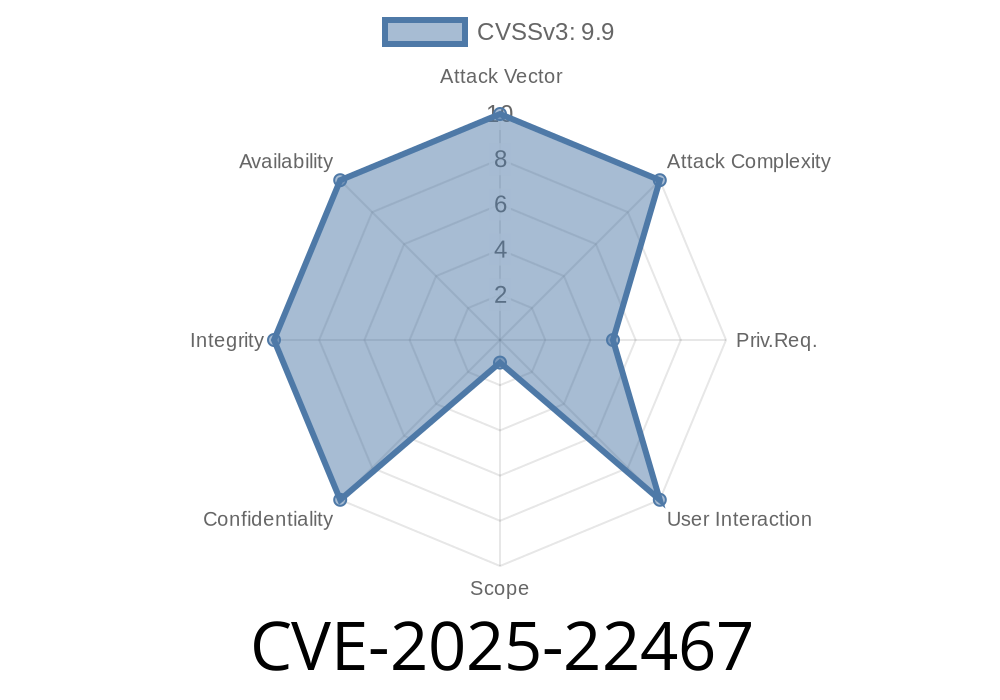Ivanti Connect Secure, a widely used secure access solution, has been found to have a critical vulnerability. This vulnerability, under the Common Vulnerabilities and Exposures (CVE) identifier CVE-2025-22467, affects versions 22.7R2.5 and earlier of Ivanti Connect Secure software. Researchers discovered a stack-based buffer overflow that can allow a remote authenticated attacker to achieve remote code execution on a system running a vulnerable version of the software.
In this post, we will take a closer look at CVE-2025-22467, including a detailed description of the vulnerability, sample code snippets demonstrating how it can be exploited, references to original research and resources, as well as tips to help you mitigate this security risk.
Vulnerability Details
The vulnerability is a stack-based buffer overflow that occurs due to improper validation of user-supplied input when processing certain network packets. If successfully exploited, this vulnerability can enable a remote authenticated attacker to execute arbitrary code on the vulnerable system with root privileges.
To exploit this vulnerability, an attacker needs to authenticate to the vulnerable Ivanti Connect Secure platform first. Then, the attacker can send a maliciously crafted packet to the server, which results in the overflow of data on the stack and potentially overwrites the return address of the vulnerable function. This behavior can subsequently enable the attacker to redirect the program's flow and ultimately execute arbitrary code on the system.
Sample Code Snippet
The following is a simple example of how an attacker can trigger the vulnerability (CVE-2025-22467).
import socket
# Set target IP and port number
target_ip = '192.168.1.100'
target_port = 443
# Create a socket connection
s = socket.socket(socket.AF_INET, socket.SOCK_STREAM)
s.connect((target_ip, target_port))
# Craft malicious payload
payload = b'A' * 1024 + b'\x90' * 16 + b'\x7f\x45\x4c\x46'
# Send the payload
s.sendall(payload)
s.close()
Note: This code snippet is for educational purposes only. Please do not use it maliciously.
Original References and Resources
To learn more details about CVE-2025-22467 and how security researchers uncovered this vulnerability, check out the following references:
1. CVE-2025-22467: https://cve.mitre.org/cgi-bin/cvename.cgi?name=CVE-2025-22467
2. Ivanti Connect Secure Security Advisory: https://www.ivanti.com/company/security-advisories/cve-2025-22467
How to Mitigate the Risk
If you have Ivanti Connect Secure deployed in your environment, it is essential to take appropriate measures to minimize the security risk associated with CVE-2025-22467. The following steps are recommended:
1. Immediately update Ivanti Connect Secure to the latest version (22.7R2.6 or later) that contains the fix for this vulnerability. To download the latest software update, go to the Ivanti Support Portal: https://support.ivanti.com.
2. As a temporary mitigation, you can configure your firewall to restrict access to the Ivanti Connect Secure platform only to trusted sources and IP addresses. This measure can help minimize the risk of exploitation by external, unauthorized parties.
3. Regularly monitor your environment for any signs of potential intrusion or compromise related to CVE-2025-22467 and report any suspicious activity to your security team.
In conclusion, CVE-2025-22467 is a critical security vulnerability that affects Ivanti Connect Secure software. It's essential to stay informed about the latest updates and security advisories to ensure the continued security of your environment. By staying vigilant and applying the necessary mitigation measures, you can significantly reduce the risk of falling victim to attacks leveraging CVE-2025-22467.
Timeline
Published on: 02/11/2025 16:15:50 UTC
Last modified on: 02/20/2025 15:53:06 UTC
